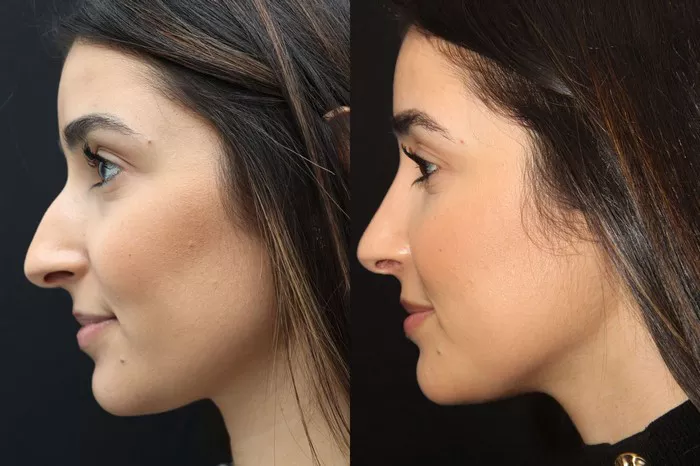A closed nose job, also known as closed rhinoplasty, is a surgical procedure that is performed to improve the appearance and function of the nose. Unlike open rhinoplasty, which involves making an incision on the columella (the strip of skin between the nostrils), closed rhinoplasty is performed entirely through incisions inside the nostrils. In this article, we will explore what a closed nose job is, the benefits and drawbacks of the procedure, and what to expect during and after the procedure.
What is a Closed Nose Job?
A closed nose job is a surgical procedure that is performed to improve the appearance and function of the nose. The procedure is performed entirely through incisions inside the nostrils, which means that there is no visible scarring on the outside of the nose.
During the procedure, the surgeon will make incisions inside the nostrils and then use specialized instruments to reshape the bone and cartilage of the nose. The surgeon may remove or rearrange bone and cartilage to achieve the desired shape and size of the nose. Once the reshaping is complete, the incisions are closed with dissolvable sutures.
Benefits of a Closed Nose Job
There are several benefits to choosing a closed nose job over an open rhinoplasty procedure. These include:
No visible scarring: Because the incisions are made inside the nostrils, there is no visible scarring on the outside of the nose.
Less swelling and bruising: Because the incisions are smaller and there is less dissection of the nasal tissues, patients may experience less swelling and bruising after the procedure.
Shorter recovery time: Because there is less trauma to the nasal tissues, patients may experience a shorter recovery time after a closed nose job compared to an open rhinoplasty procedure.
Drawbacks of a Closed Nose Job
While there are several benefits to choosing a closed nose job, there are also some drawbacks that patients should be aware of. These include:
Limited access: Because the procedure is performed entirely through incisions inside the nostrils, the surgeon may have limited access to the nasal structures. This can make it more difficult to achieve certain types of reshaping or correction.
Limited visibility: Because the surgeon is working through small incisions inside the nostrils, there is limited visibility of the nasal structures. This can make it more difficult to achieve precise reshaping or correction.
Limited correction: Because the procedure is performed entirely through incisions inside the nostrils, there may be limits to the amount of correction that can be achieved. In some cases, an open rhinoplasty procedure may be necessary to achieve the desired results.
What to Expect During the Procedure
A closed nose job is typically performed under general anesthesia, although local anesthesia with sedation may be used for less extensive procedures. The procedure can take several hours, depending on the extent of the reshaping required.
After the anesthesia has taken effect, the surgeon will make the necessary incisions inside the nostrils and begin reshaping the nose. The surgeon may remove or rearrange bone and cartilage to achieve the desired shape and size of the nose. Once the reshaping is complete, the incisions are closed with dissolvable sutures.
What to Expect After the Procedure
After the procedure, patients can expect some swelling, bruising, and discomfort in the days and weeks following the procedure. The nose may also feel congested or stuffy, and patients may experience some bleeding or drainage from the nose.
It is important to follow all post-operative instructions provided by your surgeon, including taking any prescribed medications, avoiding strenuous activity, and keeping the head elevated while sleeping. Most patients are able to return to work and normal activities within 1-2 weeks after the procedure.
Potential Complications
While a closed nose job is generally safe, there are some potential complications that patients should be aware of. These can include:
Infection: Infection is a rare but serious complication that can occur after any surgical procedure. Patients should watch for signs of infection, such as fever, redness, and swelling, and contact their surgeon immediately if they suspect an infection.
Bleeding: Bleeding is also a rare but serious complication that can occur after a closed nose job. Patients should avoid aspirin and other blood-thinning medications before the procedure, and should contact their surgeon immediately if they experience any excessive bleeding.
Scarring: While scarring is a normal part of the healing process, some patients may experience more noticeable scarring after a closed nose job. Your surgeon can provide guidance on how to minimize scarring and promote healing.
Conclusion
A closed nose job can be a safe and effective way to improve the appearance and function of the nose. By understanding the benefits and drawbacks of the procedure, as well as what to expect during and after the procedure, patients can make an informed decision about whether a closed nose job is right for them. If you are considering a closed nose job, be sure to consult with a board-certified plastic surgeon who has experience performing this type of procedure.


